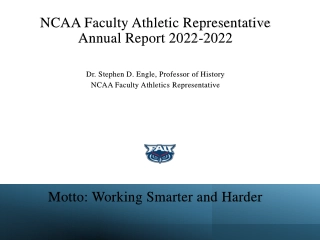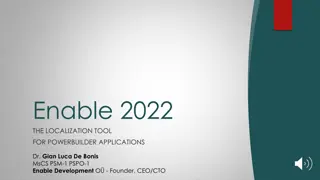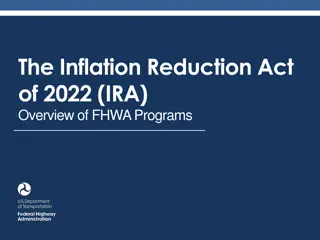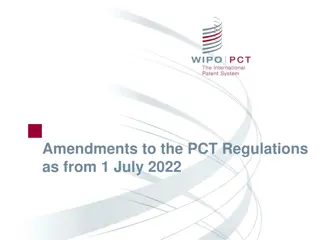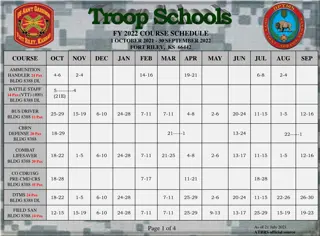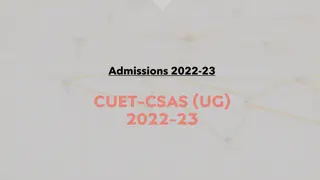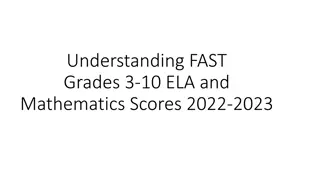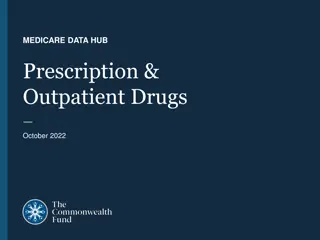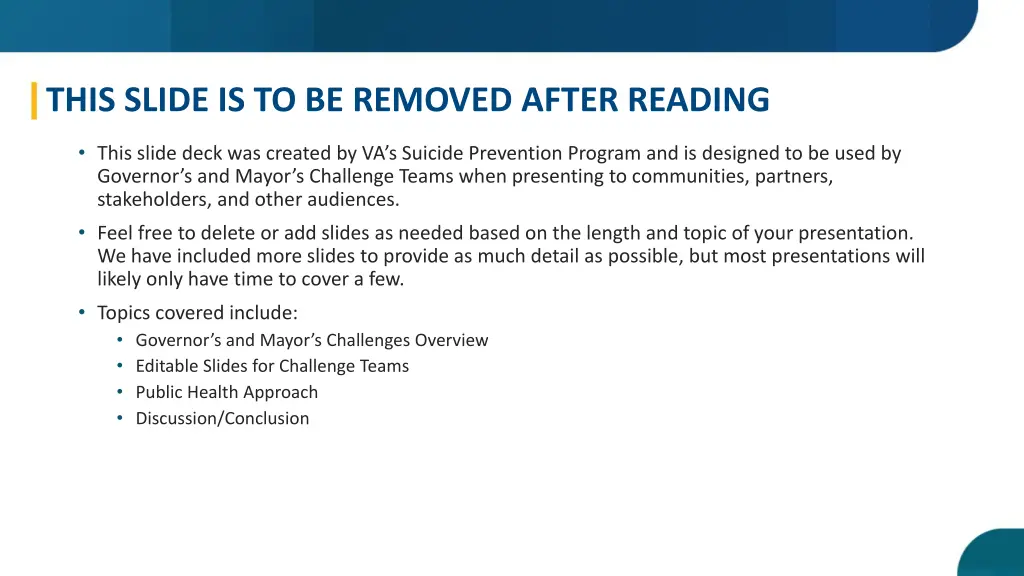
Preventing Veteran Suicide: Challenges and Collaborative Efforts
Discover how the Governor's and Mayor's Challenges aim to prevent suicide among service members, veterans, and their families. Learn about the community-based interventions and partnerships driving this crucial initiative for suicide prevention. Partnering with VA and SAMHSA, local leaders develop tailored strategies to support their populations effectively.
Download Presentation

Please find below an Image/Link to download the presentation.
The content on the website is provided AS IS for your information and personal use only. It may not be sold, licensed, or shared on other websites without obtaining consent from the author. If you encounter any issues during the download, it is possible that the publisher has removed the file from their server.
You are allowed to download the files provided on this website for personal or commercial use, subject to the condition that they are used lawfully. All files are the property of their respective owners.
The content on the website is provided AS IS for your information and personal use only. It may not be sold, licensed, or shared on other websites without obtaining consent from the author.
E N D
Presentation Transcript
THIS SLIDE IS TO BE REMOVED AFTER READING This slide deck was created by VA s Suicide Prevention Program and is designed to be used by Governor s and Mayor s Challenge Teams when presenting to communities, partners, stakeholders, and other audiences. Feel free to delete or add slides as needed based on the length and topic of your presentation. We have included more slides to provide as much detail as possible, but most presentations will likely only have time to cover a few. Topics covered include: Governor s and Mayor s Challenges Overview Editable Slides for Challenge Teams Public Health Approach Discussion/Conclusion
Title Name Team Name Location Date
Governors and Mayors Challenge to Prevent Suicide Among Service Members, Veterans, and their Families
About the Challenge States and communities have been partnering with VA and Substance Abuse and Mental Health Services Administration (SAMHSA) on the Mayor s and Governor s Challenge since 2019. Mayor s and Governor s Challenge teams develop plans to implement the National Strategy for Preventing Veteran Suicide, which provides a framework for identifying priorities, organizing efforts, and contributing to a national focus on Veteran suicide prevention. Teams work to identify their top priorities, best strategies for their community s needs, and efforts they will use to evaluate their outcomes. Not one plan will fit every community, so strategies vary across communities. This work is critically important because local leaders know their populations best. 4
Partnering Across the Nation Goal: Develop state and local plans based on the public health approach to prevent suicide. Governor s and Mayor s Challenge teams include collaborative groups of community, municipal, military, Veteran, and other stakeholders. VA/SAMHSA provide technical assistance to support local efforts, document outcomes, and share strategies with other municipalities. The Governor s Challenge took the Mayor s Challenge to the state level, incorporating existing community strategic plans within their respective states. 5
Community-Based Interventions Community-Based Interventions for Suicide Prevention (CBI-SP) serves as unifying model, from national to community levels, for all community-based efforts to end Veteran suicide. National Level National VA Suicide Prevention Program State Level Governor s Challenge state policy makers partner with local leaders to implement a comprehensive suicide prevention plan. The Governor s Challengeis a collaboration with VA and SAMHSA where Community Engagement and Partnerships for Suicide Prevention Together With Veterans building and Veteran leadership development for suicide prevention. Together with Veteransis focused on Veteran-to-Veteran coalition Community Level focused on facilitating community coalition building for suicide prevention. Community Engagement and Partnerships for Suicide Prevention is Outreach and Education provides VA SAVE, VHA facility partnerships, events, etc. through local Suicide Prevention Coordinators (SPCs) and does not change their critical role. Outreach and Education 6
Priority Areas of Focus Identify service members, Veterans, and their families and screen for suicide risk Promote connectedness and improve care transitions Increase lethal means safety and safety planning 7
[State/Community] [Governors/Mayors] Challenge Our Action Plan Highlights: Below are examples. Replace with your team s efforts: Identify service members, Veterans, and their families: Implement Ask the Question ( Have you or a loved one ever served in the military? ) by adding screening question across all government agency intake forms. Promote connectedness: Develop state-wide peer support program for Veterans and family members. Increase lethal means safety: Establish lock and talk partnerships with local gun shops to promote suicide prevention resources. Insert Logo/Photo Here if Desired 8
Team Composition If relevant for the presentation, consider adding organizations that comprise your Mayor s/Governor s Challenge team. Below are examples. Replace with your team s info: Our team is comprised of representatives from: [Governor s/Mayor s] Office [Location] Department of Veterans Affairs [Location] Department of Health [Location] Department of Human Services [Location] VA Medical Center [State] National Guard University of [Location] AMVETS American Legion National Alliance of Mental Illness Mental Health America Etc. 9
Program Highlight If relevant for the presentation, consider sharing details about one or more of the planned strategies from your team s Action Plan. Below are examples. Replace with your team s efforts: The [state/community] [Governor s/Mayor s] Challenge team plans to develop a gun lock distribution pilot program, with a planned launch in January 2023. Components of the pilot include distribution of gun locks and increasing messaging about lethal means safety, specifically towards clinicians. Outcome measures for the pilot include: # of gun locks distributed over 6 months % increase in clinicians who offer gun locks to patients pre- and post- implementation of the pilot (6- month timeframe) 10
Next Steps Describe the next steps to take toward accomplishing the goals in your action plan, or highlight any upcoming events examples below: Next steps for our pilot program involve development of messaging for clinicians around lethal means safety. We plan to conduct interviews with clinicians to understand clinician perspectives around gun locks and lethal means safety. We are currently seeking 5-6 more clinicians for interviews email [team member] if you are interested in participating! Our team is also co-hosting a Suicide Prevention Awareness event with [agency] on September 16, 2022. Go to [website] to register for the event! The team continues to meet monthly and will be providing a briefing to the [Governor s/Mayor s] Office in October. 11
Lessons Learned Through Our Challenge So Far Edit the examples below or add your own examples of lessons learned After identifying service members, Veterans, and family members, it is important to have suicide risk screening and a referral process for indicated needs. Care coordination can assist with lethal means safety efforts, like doing gun lock distribution throughout a care coordination network. Safety planning can help Veterans stay safe during a crisis and during care transitions. Be creative and flexible to match the needs of the community. Collaboration with a broad range of organizations and utilizing existing programs and resources has been key to our success. 12
The Public Health Approach VA takes a public health approach to preventing Veteran suicide. The next three slides are meant to provide background about this approach to inform your team s strategy.
VAs Public Health Strategy VA's public health strategy combines partnerships with communities to implement tailored, local prevention plans while also focusing on evidence-based clinical strategies for intervention. Our approach focuses on both what we can do now, in the short term, and over the long term, to implement VA s National Strategy for Preventing Veteran Suicide. 14
Suicide Prevention 2.0 Vision for the Distance: Combining Community & Clinical Interventions Community-Based Prevention Strategies Clinically Based Interventions Veterans Integrated Service Networks (VISN)-Wide Community Prevention (Community Coalition Building) Together With Veterans (Veteran-to- Veteran Building) Governor s/Mayor s Challenge (State- Driven Suicide Prevention Planning) Evidence-Based Psychotherapies Implemented Across the Nation (including Cognitive Behavior Therapy for Suicide Prevention, Dialectical Behavior Therapy, and Problem-Solving Therapy) Community Engagement and Partnership Coordinators (CEPCs) Foundation of Adequate Mental Health Staffing (7.72 outpatient mental health full-time equivalent employees/1,000 Veterans in outpatient mental health) 15
Anchors of Hope In 2019, there was an almost 13% one- year rate decrease for women Veterans, which was the largest rate decrease for women Veterans in 17 years. 399 fewer Veterans died from suicide in 2019 than in 2018, reflecting the lowest count of Veteran suicides since 2007. The single-year decrease of 7% for 2019 was larger than any observed decrease from 2001 through 2018 and was a more-than-four-times-greater decrease than for the non-Veteran population. So far, there does not appear to be an increase in Veteran suicides related to COVID-19, but the data continues to be gathered and will be reviewed. And yet, we need to do more. We cannot do this work without each of you. 16
Join Us in Action Suicide is a complex issue with no single cause. We all have a role to play in reducing Veteran suicide. We prevent suicide through meaningful connection, one person at a time. Here s what you can do to help prevent Veteran suicide: Become knowledgeable about suicide data and suicide prevention resources. All resources can be downloaded at: https://www.mentalhealth.va.gov/suicide_prevention/data.asp. Promote VA S.A.V.E. Training to your community: https://psycharmor.org/courses/s-a-v-e/. Help create a safe community for Veterans by posting the Veterans Crisis Line number (Dial 988 then Press 1) around your organization s offices and in office newsletters. We want all Veterans and community partners to know that help is always available. 17
Share the Veterans Crisis Line with your Networks The Veterans Crisis Line has a new, easy-to-remember number: Dial 988 then Press 1. Help spread the word by visiting VeteransCrisisLine.net to find downloadable assets. Here are a few simple actions you can take: Update your websites and digital assets with the new logo Share on social media using sample posts and graphics for use on Facebook, Twitter, and Instagram Use a Dial 988 then Press 1 email signature image and video conference background Share the pre-written newsletter, blog, and email content with your networks As mentioned in the notes section, copy and paste link to the Veterans Crisis Line PSA (library found here) that you would like to show your audience. The PSA can be played from this slide. 18
Stay Connected Follow us on social media. @U.S. Department of Veterans Affairs @DeptVetAffairs @DeptVetAffairs Add link to Instagram page Add link to Facebook page Add link to Twitter page 20
[Insert Contact Email or Team Website] [Insert image of your logo] 21


